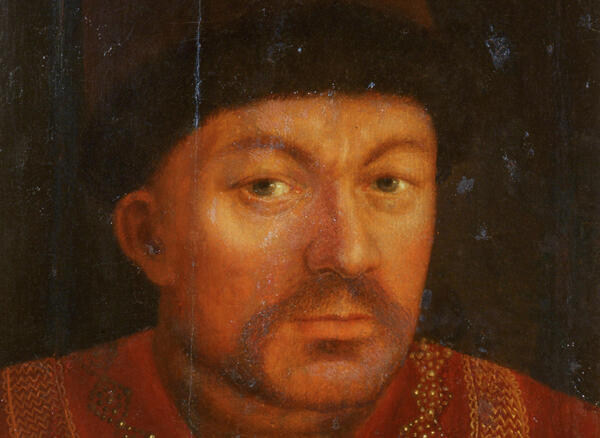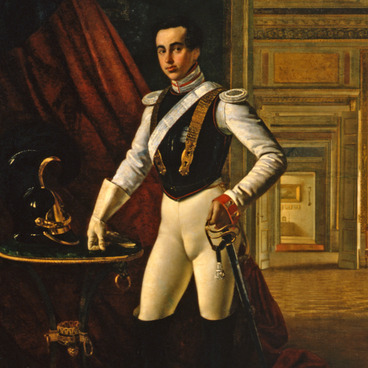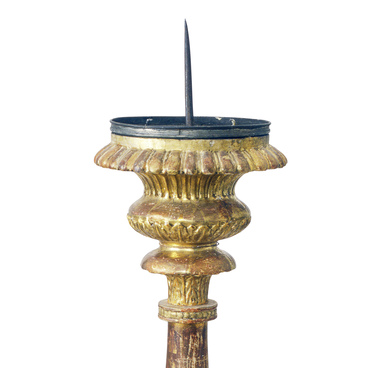The portrait of ambassador Grigory Mikulin is the earliest image of a Russian person made from life and preserved to this day. The picture is painted by an unknown artist in London: the Russian mission was based there in 1600–1601.
For over 200 years the portrait was kept in the capital of England. In 1842 it was acquired by Russian Consul General in Genoa Ivan Smirnov. He presented it to the Chancellor of the State, Count Nesselrode, who handed it over to the archives of the Ministry of Foreign Affairs a year later. The picture remained there until the revolution, later it became part of the collection of the State Historical Museum.
Grigory Mikulin came from a provincial family of minor noblemen. In his young years he served together with Boris Godunov as a “rynda” — an armor bearer and bodyguard to Tsarevich Ivan, son of Ivan the Terrible. Then, in 1571–1572, Mikulin participated in an oprichny campaign to Novgorod; in 1591, during the Russian-Swedish war, he served near Narva, where he commanded a sotnya (a military unit of 100–150 people) of Circassians and then continued his service in Siberia. When Godunov became tsar, he appointed Mikulin the head of the diplomatic mission that was sent to Queen Elizabeth of England in 1600.
Officially, the envoys were to inform Elizabeth of the coronation of the new Russian ruler. However, they also pursued other goals: for example, to find out about England’s relationship with Turkey and the impact it might have on the politics and economy of the Russian state.
Grigory Mikulin stayed in London with the mission until May 1601. The report on his posting included personal observations on everyday life in England, receptions at the court, knightly tournaments and services in the Protestant church. This report became a valuable historical source.
After Boris Godunov died, Grigory Mikulin sided with False Dmitry I. In 1605, he was appointed the head of the Streltsy (guardsmen armed with firearms) and sent to Yaroslavl to suppress mutiny among his troops. Following the death of False Dmitry in 1606, Mikulin attempted to flee to Poland, but was captured in the village of Vyazemi. In 1610, Grigory Mikulin swore allegiance to the new Russian ruler — Prince Vasily Shuisky.
For over 200 years the portrait was kept in the capital of England. In 1842 it was acquired by Russian Consul General in Genoa Ivan Smirnov. He presented it to the Chancellor of the State, Count Nesselrode, who handed it over to the archives of the Ministry of Foreign Affairs a year later. The picture remained there until the revolution, later it became part of the collection of the State Historical Museum.
Grigory Mikulin came from a provincial family of minor noblemen. In his young years he served together with Boris Godunov as a “rynda” — an armor bearer and bodyguard to Tsarevich Ivan, son of Ivan the Terrible. Then, in 1571–1572, Mikulin participated in an oprichny campaign to Novgorod; in 1591, during the Russian-Swedish war, he served near Narva, where he commanded a sotnya (a military unit of 100–150 people) of Circassians and then continued his service in Siberia. When Godunov became tsar, he appointed Mikulin the head of the diplomatic mission that was sent to Queen Elizabeth of England in 1600.
Officially, the envoys were to inform Elizabeth of the coronation of the new Russian ruler. However, they also pursued other goals: for example, to find out about England’s relationship with Turkey and the impact it might have on the politics and economy of the Russian state.
Grigory Mikulin stayed in London with the mission until May 1601. The report on his posting included personal observations on everyday life in England, receptions at the court, knightly tournaments and services in the Protestant church. This report became a valuable historical source.
After Boris Godunov died, Grigory Mikulin sided with False Dmitry I. In 1605, he was appointed the head of the Streltsy (guardsmen armed with firearms) and sent to Yaroslavl to suppress mutiny among his troops. Following the death of False Dmitry in 1606, Mikulin attempted to flee to Poland, but was captured in the village of Vyazemi. In 1610, Grigory Mikulin swore allegiance to the new Russian ruler — Prince Vasily Shuisky.



